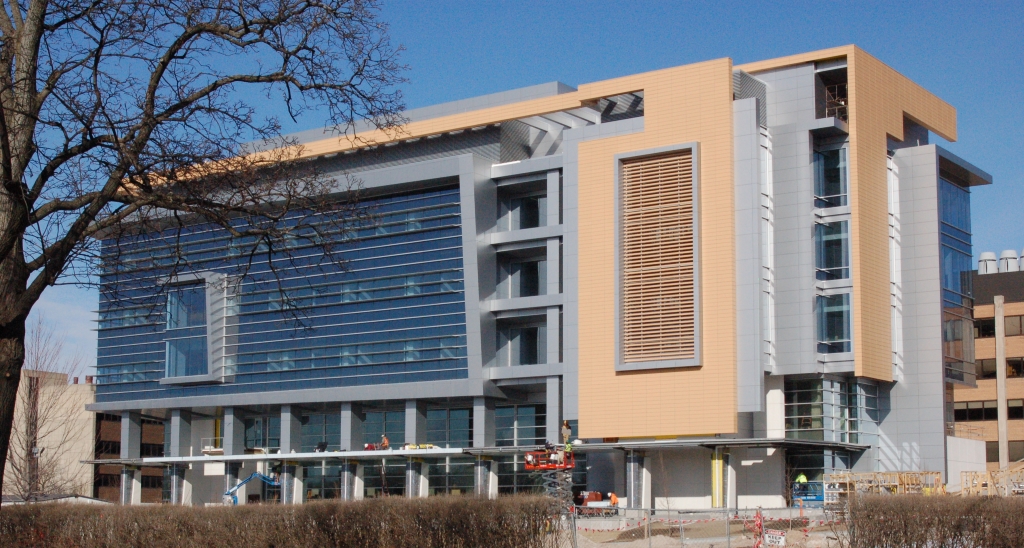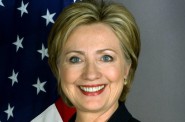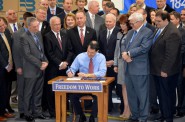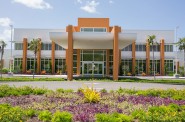The Growth of UWM Research Foundation
It's processed 41 patents in last nine years. But state funding cuts could endanger its growth.

University of Wisconsin-Milwaukee Kenwood Interdisciplinary Research Complex. Photo by Brendan Murphy.
The mood in the JCI conference room was both celebratory and anxious as Junhong Chen and five others were recognized with bronze plaques describing their new patents.
He and his fellow innovators were honored last week by the University of Wisconsin – Milwaukee Research Foundation (UWMRF) and Chancellor Mark Mone for leading the way toward a new UWM reality, that of a significant player in the world of research and development.
The celebration marked a remarkable acceleration in bringing academic research to the real world in the form of patents, licenses, startup companies and then a virtuous cycle of more research dollars. UWMRF has now successfully processed 41 patents since it launched nine years ago. That compares to exactly one in all of UWM’s prior history. It has 43 more patents pending.
The foundation has also sold 21 licenses, including four in 2014. That compares to zero beforehand.
While UWM is still in its adolescence as a research center, it is growing fast in that dimension under the leadership of UWMRF President Brian Thompson and young rock star professors like Chen.
The anxiety that took the edge off the award ceremony stemmed from the budget chaos in the state’s capitol. The people driving UWM’s renaissance are very worried that Gov. Walker’s $300 million cut to UW System’s two-year budget could undermine their remarkable progress. UWM’s share of the reduction of state support, if it is applied across-the-board to the UW’s 26 campuses, could be $20 million per year.
Dr. Chen is one example of how UWM’s expanded strategy, developed over the tenures for four chancellors, produces innovation, R&D dollars (now at the $60 million level), major partnerships with industry, patents, licenses and startup companies.
His latest patents are right on target with the M7 initiative to make the region a global hub of freshwater technology and commerce. He has developed novel sensors based on nano-materials to detect contaminants in water. Already, the foundation has developed licenses with four local water and engineering companies.
Chen also received a grant for $800,000 from the National Science Foundation for innovation partnerships through his company, NanoAfflix, which will be working with three water industry collaborators on his sensors for unsafe bacteria in water.
UWM has the advantage of being right in the heart of the state’s business center, so its academic breakthroughs can be married to channels to market in industry. Every researcher wants to see his or her ideas put to use in the real world.
The payoff for citizens and taxpayers is job creation as local companies grow faster and new companies get started. More jobs means more opportunity, upward pressure on wages, a stemming of the brain drain of more than 10,000 college graduates per year and higher tax revenues to support public services.
The state’s budgetary problems are a direct result of its lackluster performance on job creation and wage levels over the last 40 years, the recent uptick notwithstanding. Message to university leaders: you need to be players on the demand side in growing the economy, as much as on the supply side in sending out graduates for the labor market.
As former UW President Katherine Lyall once observed, Wisconsin can’t expect to sustain a first class university without a first class economy.
Here are some of the other UWM milestones recognized last week at the JCI headquarters for its Battery Division in Glendale:
- 49 disclosures of new intellectual property in 2014, the highest total ever.
- $1 million for a center for advanced computational imaging funded by GE Healthcare.
- $3.7 million in catalyst grants over seven years from the Bradley Foundation, Rockwell Automation, the Herzfeld Foundation and others, with $13 million in follow-on funding.
- Eight startup companies from UWM innovations.
- A new Innovation Campus that is co-locating technologists from UWM, other colleges and industry.
- A Student Startup Challenge that has brought hundreds of UWM students to the understanding that they can create a job for themselves as much as take a job.
In short, there is tremendous new energy in and around UWM. MaryAnn Wright, vice president of engineering and product development for JCI and vice chairman of the foundation, extolls the relationship with UWM. And JCI’s commitment is more walk than talk, including a JCI Lab right in UWM’s engineering complex. Her engineers have “a one-to-one relationship” with researchers at UWM like Chen.
She uses the word “transformative” to describe what the collaboration can do for Wisconsin’s prosperity.
John Torinus is the chairman of Serigraph Inc. and a former Milwaukee Sentinel business editor who blogs regularly at johntorinus.com.
Torinus
-
How Hillary Could Win GOP Votes
 May 9th, 2016 by John Torinus
May 9th, 2016 by John Torinus
-
Walker Targets Health Care Savings
 Feb 2nd, 2016 by John Torinus
Feb 2nd, 2016 by John Torinus
-
Cheap Surgery on a Tourist Isle
 Jan 12th, 2016 by John Torinus
Jan 12th, 2016 by John Torinus





















So is this when we start writing hundreds of articles, each pointing out a positive benefit the UW system provides, and then fear monger by saying the 300 million is going to destroy that benefit? Like the whole system is going to collapse and we’re gong to revert to a third world country.
I still have yet to hear anyone claim that the system runs as efficiently as possible and there’s absolutely no room to find any savings.
Your argument is flawed, it comes from the premise that the whole system is run as one institution, the cuts that UWM in particular face, are drastic and could harm all the good things that are occurring.
Instead of my assumption being the flaw… do you think maybe the flaw is the fact that it’s NOT run as one institution?
Won’t $40 million be cut from UW-Milwaukee if the UW system cuts are approved? If so, it doesn’t seem like fearmongering to suggest that the cuts could endanger growth and have serious negative consequences. I’m not saying efficiencies can’t be improved or that $0 should be cut, but $40 million for one university is a very big cut.
AG, let’s hear you out. Can you show me an example where a system like the UW is run the way you propose & succeeding?
I understand the skepticism, but if you look at some of the regents own comments from when this story first broke you’ll see that they don’t necessarily think it’s impossible… especially if they get the flexibility to make the changes the way they want. For example, they’ve mentioned things like consolidating redundant HR functions, combining purchasing, controlling their own building operations and construction programs, and more. Making it more palatable yet is if they can control how much is cut on a given year. E.g. if they could make a small cut first year and majority in the second year.
Also, being a semi-autonomous entity they can look at things like redundant programs, resource allocation, etc.
It certainly seems like a monumental task to make these cuts in an intelligent way without hurting the education. There’s no denying that. But is it impossible? I’m not convinced that a system as large as the UW system and as mired in bureaucracy can’t find 2.5% in cuts over 2 years.
This cut is very minor in the scheme of things. $20 million per year will be cut from an annual budget of $546 million. That’s a 3.6% decrease in funding. It is hardly devastating and should be easily absorbed. Look at your own household’s budget. If you couldn’t cut 3.6% from it, you’re doing it wrong. Of course, it is in the school’s interest to make the cut look as dramatic as possible, and apply it where it will hurt the most and be publicized the most.
By the way… if the research part of the school is doing such valuable work, they should easily be able to make up any funds lost through selling more patents, etc.